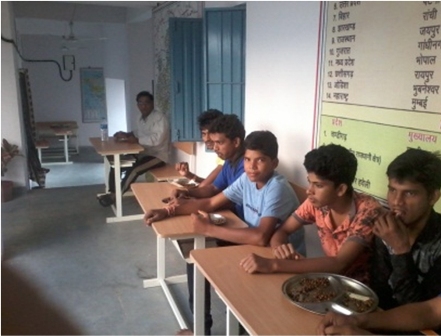Democratization of Education – a PSR Driven Initiative
Dr. Subhash Kumar Joshi
Plethora of facts and critique on education system are available from government and non-government sources. One approach could be to spend time and energy in vetting or contradicting these reports, while the other is to see - what best can be done so that democratic right of open and equal opportunity of education is available to every child? Within the alms of democracy, as defined by Abraham Lincoln, author holds himself responsible, if there is a single child who is not as blessed as him, and his family, to receive the care and quality in education which places them where they are. This, together with philosophical realization of the author prompted him to take a plunge into latter of the two approaches, stated above, as a Personal Social Responsibility (PSR). Experiences in this initiative are summarized and considered apt for sharing among those who are engaged in educational empowerment of people who either did not have opportunities, or are dropouts of the prevalent system of education, with a spirit of complementation and not competition. In this pursuit, it is of paramount importance to remember that aim of education is not to create innovators, but to make a common man do what otherwise cannot.
Introduction: In a flourishing economy a surge of students for a professional career is observed. A student craving for a professional career is one thing, while qualifying for a professional course is another thing, and becoming a professional is altogether different. Taking a case of engineering studies, in urban India, most of the students of mathematics-science takes up coaching or tuition in one or the other form and aspire to get a seat in institutes of excellence like IITs and NITs. These institutes do not have a room for every such aspirant, and as a result unsuccessful students disperse into various professional colleges spread across the country. Aspirations of a student to make a choice of career is ones democratic right and remains undisputed, but should that craze be commercialized? This gives rise to another argument; can the right of commerce in any field, be it education, be constrained or regulated in a democracy? Answer to these questions requires a consideration of the education as a fabric that shapes the future of nation, while commerce goes into making the journey towards future sustainable, viable and stable.
It is observed that education leads to migration of rural and semi-urban population to urban centres, and even overseas, in search of better opportunities. Same is experienced with the skilled work force. As a consequence traditional skills get abandoned and a vacuum of skill is created. It is, therefore, compelling to look into dynamics of skill and education. Traditionally skill is related to working class who inherit it as a family legacy, while management is considered to be a domain of elite and educated class. This is a latent and discrete social division into working class and elite class. Moreover, technological developments have greatly influenced commonly known traditional skills viz. hair dressing, carpentry, tailoring, photography, composing and printing, drawing, painting, animation, music etc. In such a transitory scenario practitioners’ of traditional skill get into gradual obsolescence unless they adapt to the state-of-the-art. Eventually, the skills are being lost in the oblivion unless suitably trained persons come up.
Skills are broadly classified into production or creative ones. Production skills require accuracy, speed and neatness and are a subject of commercialization, as well as support to livelihood and aspirations of the workers. In creative skills uniqueness and ingenuity is an additional attribute and these are pursued by persons with passion for it, or those who are relatively well placed. The bitter fact about skilled workers is that they remain workers despite passage of times. On the contrary with growing age, productivity and in turn their financial security depletes. In such a scenario, the only recourse with them is either to become entrepreneur or upgrade their knowledge at a right time, and thus guard against insecurities inflicted upon them by compulsions beyond their control.
Migration of skilled workers during industrial growth, with a consequent increase in their affordability, creates a gap in demand and supply of skilled workers. This is where development of skill in a traditional manner is unable to cater to the demand of industrial growth. It, further, necessitates development of industry-ready skilled workers through formal education and training. This has been attempted through institutes, like ITIs and polytechnics, where formal education and training, involving a mix of academics and vocational practices, is imparted. In the prevalent era of industrialization, global economy and technology, automation and economics of scale is a necessity. In this scenario, engagement of qualified engineers in operation, maintenance, design and manufacture becomes essential. Gap in academia and technological needs of an industry, unless supplemented with industry specific vocational or induction training, any amount of efforts in skill development at institutional level would remain insufficient. Likewise, any technological upgradation in a industry needs to be managed with on-job training. These problems and challenges of skilled workforce, both quantitative and qualitative, unless managed properly, the growth of a company is jeopardised. Apart from this, there are much larger segments of unskilled and uneducated work force seeking survival options; their children either remain first generation students or unable to take advantage of educational opportunities.
As regards qualified human resources in core disciplines a trend of a severe drift towards IT, finance and management opportunities began during 1995-2005. As a result of this, core sectors are experiencing acute shortage of qualified manpower and their willingness to work at level of production, operation and maintenance (POM). Eventually, developed economies across the globe started relocating their POM activities to developing economies. This is an opportunity for India to capture the POM market, and for this it has to come up with qualified and trained human resources, both quantitatively and qualitatively.
A perspective of excellence building on a group of socially and economically unprivileged students is conceptualized in a pyramid formation, as shown in t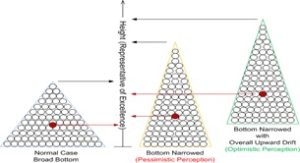 he figure below, comprising of a group of students. In this pyramid bottom represents weakest student and the top is the best. A score of reasons can be attributed to relative difference in level of occupants in the pyramid, and is shown as base case. An effort to press upon the development of occupants, at any level, would cause a turbulence and reallocation of the members of the group in the pyramid, like that of molecules in a water filled balloon. Eventually such efforts at the bottom of pyramid would narrow it down with a consequent increase in its height, representing rise in the level of the best student, and average level represented by dark spot; volume of the water vis-a-vis number of students remains unchanged. This model in context of educational empowerment takes a pessimistic proposition wherein there are some students who remain unaffected. This proposition is very much unlikely in an inclusive approach to education, which is being proposed. Therefore, an optimistic view suggests that there would be lifting of the bottom of the pyramid, together with its reshaping as elaborated above. Extent of lift and reshaping, tending to make it cylindrical, would depend upon intensity, continuity and consistency of efforts. Eventually, within the macro pyramid, there would be many mini and micro pyramids, each having an apex, bottom and intermediate layers to provide occupancy to every individual, in the field of passion, based on one’s ability to pursue it and the degree of consistency, continuity, intelligence, strategy and commitment.
he figure below, comprising of a group of students. In this pyramid bottom represents weakest student and the top is the best. A score of reasons can be attributed to relative difference in level of occupants in the pyramid, and is shown as base case. An effort to press upon the development of occupants, at any level, would cause a turbulence and reallocation of the members of the group in the pyramid, like that of molecules in a water filled balloon. Eventually such efforts at the bottom of pyramid would narrow it down with a consequent increase in its height, representing rise in the level of the best student, and average level represented by dark spot; volume of the water vis-a-vis number of students remains unchanged. This model in context of educational empowerment takes a pessimistic proposition wherein there are some students who remain unaffected. This proposition is very much unlikely in an inclusive approach to education, which is being proposed. Therefore, an optimistic view suggests that there would be lifting of the bottom of the pyramid, together with its reshaping as elaborated above. Extent of lift and reshaping, tending to make it cylindrical, would depend upon intensity, continuity and consistency of efforts. Eventually, within the macro pyramid, there would be many mini and micro pyramids, each having an apex, bottom and intermediate layers to provide occupancy to every individual, in the field of passion, based on one’s ability to pursue it and the degree of consistency, continuity, intelligence, strategy and commitment.
Genesis of Model: The author based on his lifetime learning and experiences took up an initiative in May’12 to offer educational guidance to students from unprivileged families. Sarthak Prayash, NGO, Ghaziabad, initially provided infrastructural support to the endeavour.
In any conglomeration individuals are differentiated by their thought process, which c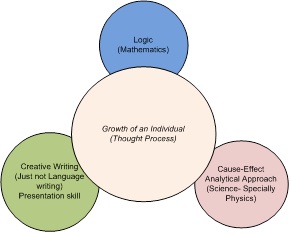 ons
titutes three attributes viz. logical skill, analytical capability and presentation skill. These three attributes can be developed with learning of Mathematics, Physics and Language, as depicted below. This forms the basis of choice of subjects. While, as a language English is targeted because it suits to the cross-section of students being addressed, who are studying in English medium scho
ols. A good understanding of subjects, being learnt, requires ability in students to dream and question How and Why in a language which is medium of learning. It is another fact that the understanding of English language in the target students is extremely poor. Accordingly, choice of English is constrained by circumstances, without disrespect to Hindi.
ons
titutes three attributes viz. logical skill, analytical capability and presentation skill. These three attributes can be developed with learning of Mathematics, Physics and Language, as depicted below. This forms the basis of choice of subjects. While, as a language English is targeted because it suits to the cross-section of students being addressed, who are studying in English medium scho
ols. A good understanding of subjects, being learnt, requires ability in students to dream and question How and Why in a language which is medium of learning. It is another fact that the understanding of English language in the target students is extremely poor. Accordingly, choice of English is constrained by circumstances, without disrespect to Hindi.
In this initiative choice of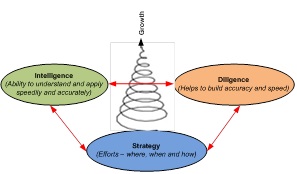 students was made for class 8th to 10th. In respect of students below this level it is difficult for author to do justice to the students. Moreover, the initiative being single person centric choice of subjects had to be limited to those where author is at his best. Moreover, students upto class 7th study ratio-proportions, theory of indices and Pythagoras theorem, which are elemental mathematics and are considered to be apt for building concepts for higher learning. Students of higher classes were deliberately excluded because their basic concern is result in entrance test; post 12th Class. At this point of time a student needs more of practice of concepts in problem solving so as to build accuracy and speed. Further, the choice of the level of target students is strategic. At this level students are firstly malleable and ready to enjoy thrill of learning and concept building because there is no pressure of immediate results. As regards intelligence it is not considered to be discrete from diligence, rather it grows with diligence, and thus it helps to increase comprehension, accuracy and speed, attributes of intelligence. Inter-dependency of three prerequisites of growth is depicted below.
students was made for class 8th to 10th. In respect of students below this level it is difficult for author to do justice to the students. Moreover, the initiative being single person centric choice of subjects had to be limited to those where author is at his best. Moreover, students upto class 7th study ratio-proportions, theory of indices and Pythagoras theorem, which are elemental mathematics and are considered to be apt for building concepts for higher learning. Students of higher classes were deliberately excluded because their basic concern is result in entrance test; post 12th Class. At this point of time a student needs more of practice of concepts in problem solving so as to build accuracy and speed. Further, the choice of the level of target students is strategic. At this level students are firstly malleable and ready to enjoy thrill of learning and concept building because there is no pressure of immediate results. As regards intelligence it is not considered to be discrete from diligence, rather it grows with diligence, and thus it helps to increase comprehension, accuracy and speed, attributes of intelligence. Inter-dependency of three prerequisites of growth is depicted below.
Philosophy: Experience of inculcating a habit of questioning How and Why of every concept is phenomenal. It is seen that students, who feared mathematics and physics, are able to understand it, and take a joy of learning. These two subjects are complementary to each other, as much as comfortable for the author to give in the best, where he is at best. The mentoring of students of class 9th and 10th is done as if they are in class 11th and 12th involving higher concepts of mathematics viz. vectors, calculus, coordinate geometry and higher algebra, and taking examples from day-to-day observations of students in their surroundings. As an example, chapter 2 of NCERT book of science, class 9th, makes a passing reference of centrifugal action for separating components of a mixture. This is just insufficient to satisfy inquisitiveness of children which arises naturally. But, clarifying how and why of the concept required to explain vectors, trigonometry and calculus. Satisfaction of this experiment provided an impetus to adopt an open model for mentoring first generation students, moving beyond the curricula. This requires removal of blinders of curriculum to interleave each and every topic of relevance, at that point of time. Thereby, journey of learning is integrated, and not fragmented.
Problems of students from elite families, despite affluence, are different due to excessive comforts, over protection, security of career, over occupation of parents and at times lack of awareness of prerequisites for knowledge and excellence. As a result these students are generally seen to be either shying off competitive examinations or confining to class at the most school level competitions. This model envisages induction of students from elite families in a group learning environment where better students or those in higher classes solve difficulties of others; thereby they improve upon their own concepts as well as translate the group synergy into better compassion, coexistence and team spirit, a necessity in real life.
Learning and rise in level of mathematics is akin to climbing of stairs, step-by-ste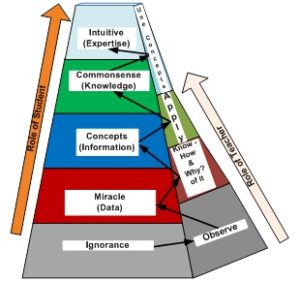 p, and just not hopping. The target students, generally very weak in academics, are subjected to revisit mathematics, without any escape, right from tables for which necessary support of books and guidance is provided. It takes little time for students to realize the advantage of hard work with an orientation, but when they do it they get motivated to self-study and practice, for capability building; a real objective of education – liberation of bondage without loss of mutual respect. This, together with biological growth of mind of target students, counters the disadvantage of severe retardants in continuance in the model, viz. low academic level, and to some extent their socio-economic environment. In the model mentors and their level of motivation is the primary factor that catalyzes the building of concepts of students and shaping them into commonsense and intuition, through rigorous practice as brought out in graphics below. There are no shortcuts to knowledge and excellence; it comes through self-carving, which has to be done by the student.
p, and just not hopping. The target students, generally very weak in academics, are subjected to revisit mathematics, without any escape, right from tables for which necessary support of books and guidance is provided. It takes little time for students to realize the advantage of hard work with an orientation, but when they do it they get motivated to self-study and practice, for capability building; a real objective of education – liberation of bondage without loss of mutual respect. This, together with biological growth of mind of target students, counters the disadvantage of severe retardants in continuance in the model, viz. low academic level, and to some extent their socio-economic environment. In the model mentors and their level of motivation is the primary factor that catalyzes the building of concepts of students and shaping them into commonsense and intuition, through rigorous practice as brought out in graphics below. There are no shortcuts to knowledge and excellence; it comes through self-carving, which has to be done by the student.
Mathematics and Science builds in a person ability to judge feasibility of a proposition, while Engineering builds an ability to make things happen in a viable manner. Other streams of education, without any prejudice, are more of subjective in nature. This has, perhaps, prompted researchers and academicians, in other disciplines, to opt for scientific approach to measurement and estimation of related variables and thereby make cause-effect analysis.
In the model efforts of students towards learning are respected, while inabilities of students’ are handled differently by mentor to evolve alternative in delivery of concept and practice thereof. If that also does not work, mentor works together with student to explore choices that can be made, for growth, based on individual’s aptitude and inherent capabilities. This helps a student to accept his position in the pyramid for immediate survival and be optimistic for ascending in the pyramid based on preparedness and will. This develops in students a respect for those who are placed at higher levels in pyramid, without any envy, agony or stress, and complacence for their level in the pyramid. This is also substantiated by Darwin’s Theory of survival of the fittest.
Mathematics is generally a most frightening subject among target students and its complexity increases if their parents had lived with similar phobia. This phobia is removed by simplifying mathematics as a natural language; a language of solving problems and not a problem. This is corroborated by the fact that poetries of तुलसीदास, सूरदास कबीरदास and many more ancient poets contains दोहे, चौपाई, श्लोक etc. to which mathematics is inherent, but none of these great poets ever had any kind of learning of mathematics. Teaching of mathematics is only formalization of this natural and inborn instinct of human being.
World of mathematics, science and engineering is privileged to us by our predecessors, through their unrewarding hard work. This world rests on  three basic branches of mathematics viz arithmetic, algebra and geometry. All other branches of mathematics are built using fundamental mathematical operations like addition, subtraction, multiplication and division on the three basic entities. It is similar to the use of stiffeners in a tower structure. It is no exaggeration that learning of mathematics and science and its pursuit, if properly mentored, is highly enjoyable and relaxing. It is no less than meditation of the highest order. Moreover, it would unfold diverse opportunities to those who may choose career in any field, other than engineering, as well as provide the nation with a large number of students ready for state-of-the-art skill development.
three basic branches of mathematics viz arithmetic, algebra and geometry. All other branches of mathematics are built using fundamental mathematical operations like addition, subtraction, multiplication and division on the three basic entities. It is similar to the use of stiffeners in a tower structure. It is no exaggeration that learning of mathematics and science and its pursuit, if properly mentored, is highly enjoyable and relaxing. It is no less than meditation of the highest order. Moreover, it would unfold diverse opportunities to those who may choose career in any field, other than engineering, as well as provide the nation with a large number of students ready for state-of-the-art skill development.
Implementation: In this model mentoring is free of charge, and it has been in operation for more than three years, during which efforts were made to spread it to schools, institutions, and acclaimed NGOs as well as individuals operating for educational empowerment of unprivileged students. This model is open to one-and-all with total freedom to add, delete and correct, as deemed fit, with only one request not to scrap it blindly and deafly. It is observed that all of them are either focussed only on literacy, or they are too closed and protective in their operation. Eventually, the model is yet to spin out of the personalized and localized initiative. Nevertheless, implementation of the model emphasizes upon –
- To develop problem solving capability in students rather than providing them solution. Mentor is neither a key nor an encyclopedia; he is to work with students to evolve solutions. Students who try to seek solution, without initial attempts so as to escape from hard work, are discouraged.
- To inculcate spirit of group learning among students which enhances their learning quality, build them into good team players to complement while competing, a strong attribute of a powerful personality and a necessity in global competition.
- To guard one-self from temptation of seeking help, mercy, charity etc, as they would turn them into a parasite, a sweet poison to kill their self-confidence and ingenuity.
- To welcome participation of elite class in the model with तन और मन and not धन. It is easy to garner धन but, it is difficult to sustain objectivity in its use.
- To impress upon students that there are no short cuts to learning and excellence; one has to carve himself.
- To open the model for adaption without any kind of propriety. It is also open to learning beyond curricula. It mentors students for building their capability and to compete, a tough proposition. However, it is neither an open school nor it offer any kind of certification.
- To make students to be regular, open to express problems in learning and their inquisitiveness, and be ready to work extra hard.
- To create a thrill of learning in students, facilitate their learning, make them envision and orient their efforts to make their dream come true, in a graded manner. It calls upon mentor to have lot of patience and perseverance.
- To upgrade students at the level of 12th , by the end of summer vacations of 10th This would leave students in class 11-12th to practice for increasing comprehension, accuracy and speed. In this pursuit, target students would be extended guidance in problem solving, as and when needed.
n 66th R’Day, society of the apartment, where author stays, took pride of the initiative and permitted the use of Kids Room, a common facility, to conduct mentoring of target students who are outsider to the society. Further, few inmates of the society are actively considering their participation in mentoring students of unprivileged class. It is believed that this model is passing through test of time for author to prove sense of his conviction, commitment and objectivity, before it receives wider acceptance for a larger good. History is a witness that no such selfless initiative was ever accepted easily, on the face of it.
Why PSR? : Each of the reader may have claim of one’s own accomplishments and being where one is. But, it is a fact that there are score of socially and economically unprivileged people who have contributed in making our fortune during our formative stage. Those who find this realization to be hard to confess, are requested to visualize present or future of their children without the kind of educational environment in which they were groomed. Further, commercialization in education system is making reach of unprivileged students inaccessible to good education. This realization has not only given rise to concept of personal social responsibility (PSR) but also to act and pursue it to the extent possible. If elite class fails to take upon themselves the cause of quality education, just not education, as PSR, a frightening future where anarchy and social aberrations dominate might be inevitable.
Response: There have been large number of dropouts in the model and it is attributed to many and complex socio-economic reasons beyond the gamut of the author. Further, his inability to help admission of target students in 11th class, in mathematics-science stream, delineated them from the model. Some students could not visualize advantage of revisiting mathematics from beginning and were eventually unable to cope up with their peer. Schools that were approached to allow operation of this model, in their off-timings, wanted a compensation for extending their infrastructure. Perhaps, they are too naive and materialistic to appreciate the latent benefits of improvement in quality of their students and teacher, and philanthropic credentials at no incremental cost to them. Despite, students who continue in the model have reason to hope for right happening at right time. Moreover, their faith in the model and in them, to be able to carve their way, is highly encouraging.
Roadmap: This model, if it has to reach to the needy students effectively and without discrimination, there is a need to grow it in a horizontal and vertical formation, without claiming any kind of personal propriety. Accordingly, Objective of the model has been set to transform unprivileged children through education into good human being; eventually build them into good professional. This objective is of an upward growth, against gravity, and is therefore bound to experience all kinds of resistance. Meeting out the objective requires a spirit of Mission to de-commercialize educational guidance as a PSR to elevate children to the level of professional competence. The ultimate Goal of the model is to ensure that every child has an equal and open opportunity to enhance capability and compete. Accordingly a roadmap for furtherance of the model is conceptualized as under –
- Initially, identify one school and promote it to act as facilitator and make its infrastructure available for the model, beyond their school hours. Mentoring session would be held outside school hours where students of the school and from the neighbourhood can join without any charges. The school would be encouraged to motivate their teachers to join the model as mentors for building self-capability.
- Multiply the model into more schools, at local level, and to act as facilitators.
- Promote colleges at district level and institutes like IITs and NITs to act as state level coordinators to attract more schools, across the state, in the model as facilitators, and provide start-up guidance to implement the model. However, customization of the model at each centre, in view of local constraints, shall be allowed without loss of focus. It shall also promote other disciplines of skill and academics based on availability of mentors.
- Constitute a National level Steering Committee constituted by experts in the field of skill development, higher secondary school education and higher education. The committee shall maintain autonomy across facilitators and coordinators, consistency of focus, garner support of government, academic institutions and industry in furtherance of the model. It shall also periodically review the model to maintain its relevance.
- Motivate colleges running National Service Scheme (NSS) programs to implement this model through their students, in school(s) of their choice. Students are moving resource and can contribute to continuance and enrichment of the model year-over-year.
- Encourage students of elite families to join model, if they choose so. But, instead of charges, for receiving benefits in the model in wake of their affordability, they would be required to facilitate at least one student of target group. This would build in them sense of compassion and sensitivity, together with a team spirit and need of coexistence; a much higher value in return.
- National level committee and state coordinators would endeavour to orient efforts of different agencies operating in the field of education as philanthropists for a larger good.
- Each of the centres at local, state and national level would garner financial support from charitable agencies and its utilization for operation of centres on ZERO FUND and ZERO ASSET bases, while suitably compensate the mentors. Though this is a new concept, it stipulates that neither any kind of funds nor assets shall be claimed by the facilitators, coordinators, or steering committee. The sponsoring organization themselves shall handle and funds and own assets required for operation of the model. This is essential to ensure that such initiatives in the name of philanthropy do not become commercial.
- Develop a manual on the way subjects are mentored in the model, which other mentors could use it as a template and adapt it for customization.
- Expand base of academic, skill and disciplines to the extent mentors are available.
- Use ICT as backbone bilateral network for integration and consolidation of facilitators and coordinators to augment reach to students, both quantitatively and qualitatively.
The functioning of the model is shown in the figure below. At the first go it would be professional, and not the least commercial. A caution is raised to refrain from using the two discrete terms interchangeably, which might defeat a trust in the model. Accordingly, as shown below the model shall be managed like a corporate where actions are planned, coordinated and executed with proper focus to the objective, mission and goal. Commitment of the players in the model shall be maintained with a sense of ownership, similar to that prevailing in an entrepreneur. Involvement in the model has to be of the order of a dedicated teacher whose sole objective is educational and enrichment of values in pupils. These all are just nice words, but of no avail, unless in the players of the model there is a sense of desperation of a student or achiever to make their dreams happen. In Indian mythology, एकलव्य is an excellent example of desperation.
Conclusions: The model is conceived with a sense of Personal Social Responsibility and not philanthropy as being practiced by many individuals and NGOs engaged in such initiative. Even if initiatives in education are construed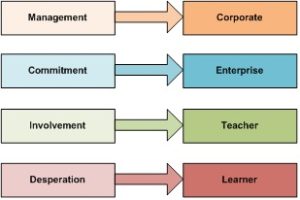 as philanthropy, none need to be competitor especially when a large potential is available for as many players as can come forward. Real necessity is to complementing efforts of each other in a focussed manner with a proper vision, a real demonstration of the spirit of philanthropy. In the model care needs to be taken to ensure that while imparting academic excellence dignity of labour is upheld. This is essential to ensure that target students do not get delineated from hard work and needs of ground reality.
as philanthropy, none need to be competitor especially when a large potential is available for as many players as can come forward. Real necessity is to complementing efforts of each other in a focussed manner with a proper vision, a real demonstration of the spirit of philanthropy. In the model care needs to be taken to ensure that while imparting academic excellence dignity of labour is upheld. This is essential to ensure that target students do not get delineated from hard work and needs of ground reality.
In real world nothing is impracticable, but viability is invariably questioned. In this connection reference is made to Faraday who was questioned about utility of the dynamo invented by him. Faraday’s gave a very optimistic and humble reply – “it has the same utility as that of a new born child”. Some readers might find propositions in the model quite naive and impracticable in its spirit, in absence of a commercial perspective and immediate gains. Such readers are requested to recall a famous quote of Confucius - If you think in terms of a year, plant a seed; if in terms of ten years, plant trees; if in terms of 100 years, teach the people. Author has no hesitation to confess that he is one of the most selfish persons to invest, in this model, his life time earning and advanced age. The self interest lies in promoting an era where his descendants would coexist with mutual respect for competence of everyone and without expecting mercy in their tough times. The only satisfaction at the end of the day is - परमार्थ में स्वार्थ और स्वार्थ में परमार्थ and it is a step towards democratize education. This is seen by the author as a means to return back to the society, as PSR, a part of all the good that he and his family has received all through. Success of this non-commercial model of educational empowerment of unprivileged students is envisaged to bring back our cultural heritage of गुरु-शिष्य परंपरा where bondage of a teacher with his taught shall not be of give and take relationship, but of dedication, and commitment.
Author is an electrical engineer, and had his professional career of nearly 3-1/2 decades in power utilities. After superannuation, he did Ph.D. from IIT Roorkee, and there after took up this initiative in 2012. Feedback of readers is welcomed by author on mail ID: subhashjoshi2107@gmail.com.
Read More
